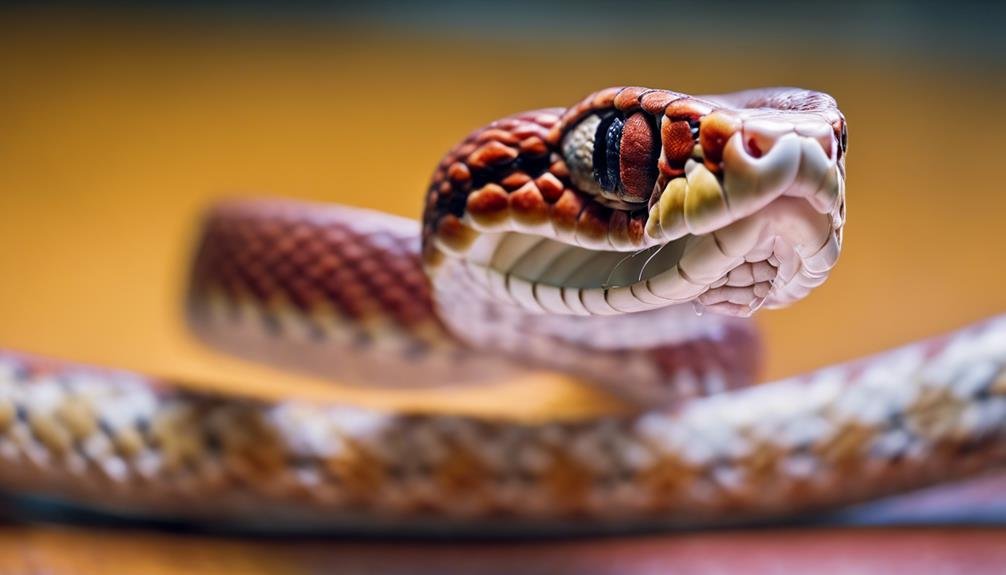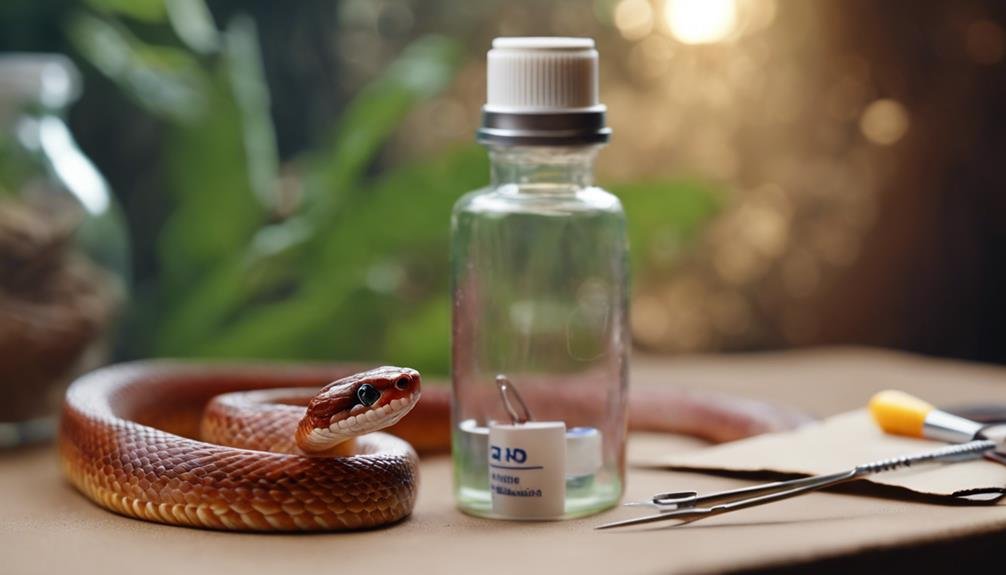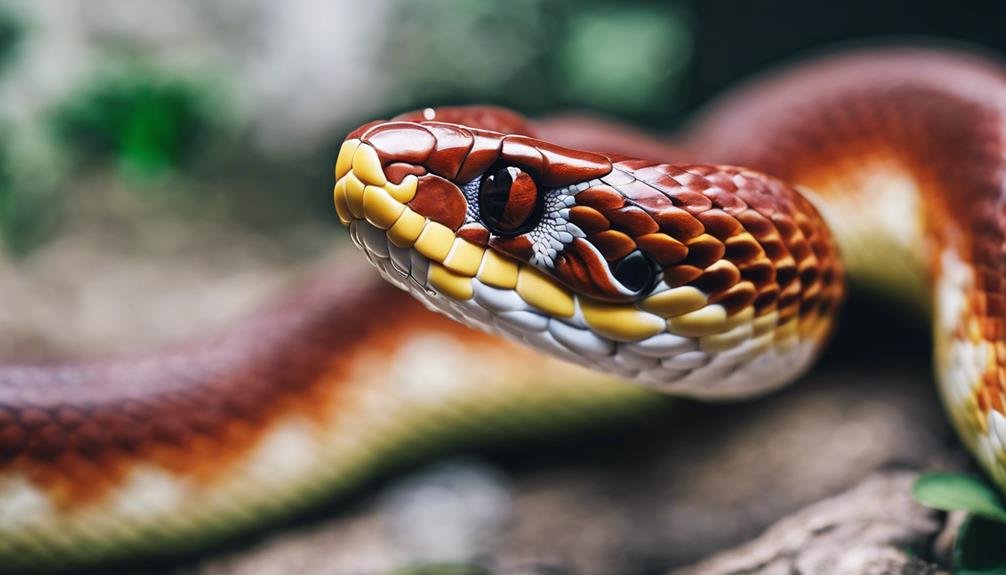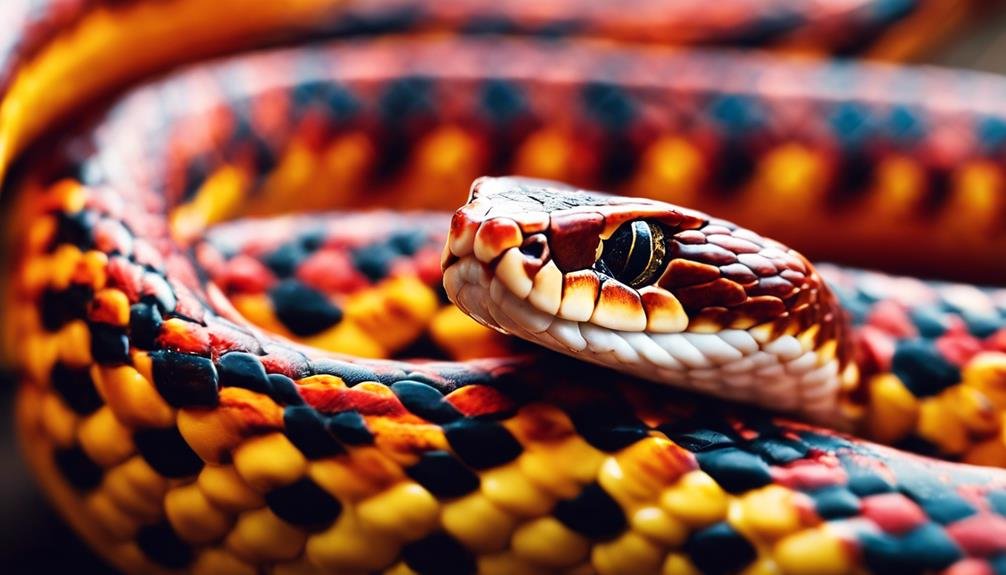You might be wondering about the dental anatomy of corn snakes and whether their teeth are big or small. Indeed, corn snakes do have teeth, albeit small and sharp, designed to grip their prey securely. With a surprising number of teeth lining their jaws, these reptiles have evolved a fascinating mechanism for feeding and survival. But how exactly do these tiny teeth function, and what should you expect if you’re on the receiving end of a corn snake bite? Let’s peel back the layers on this topic, uncovering some intriguing facts and debunking myths along the way.
Key Takeaways
- Corn snakes have small, sharp teeth designed for grasping prey.
- They have up to 30 teeth in the upper jaw and about 28 in the lower jaw.
- The teeth are not used for venom delivery, as corn snakes are non-venomous.
- Their teeth are curved to hook into prey, preventing escape.
- The purpose of corn snake teeth is primarily for holding onto prey during constriction.
Understanding Corn Snake Teeth
Corn snakes possess a set of small, backward-curving teeth designed for a firm grip on their prey, highlighting the importance of handling them with care. These sharp teeth play a vital role in their ability to secure their meals. Unlike venomous snakes that rely on poison to immobilize their prey, corn snakes are constrictors. This means they use their muscular bodies to suffocate their catch, with their teeth ensuring the prey doesn’t escape during this process.
Though their teeth aren’t venomous, it’s wise to practice proper wound care if you’re accidentally bitten. Their teeth may be small, but they’re sharp enough to puncture the skin. Cleaning the wound promptly reduces the risk of infection, including preventing possible respiratory infections that can stem from bacteria.
Understanding the nature of corn snake teeth is key to handling them safely. Knowing they’re not meant to cause harm but rather to aid in feeding can ease any apprehension. It’s about respecting their natural behavior while ensuring both your safety and the well-being of the snake. Remember, their teeth are small and not designed to inflict serious injury, but handling them with knowledge and care is always advisable.
The Function of Teeth in Corn Snakes
You’ll find that corn snakes use their teeth primarily for grasping tightly onto their prey, an essential step before they start the process of constriction.
These teeth also play an important role in the snake’s digestive system, aiding in the initial phase of breaking down their food.
This mechanism is essential for their survival, ensuring they can efficiently capture and consume their meals in the wild.
Teeth Role: Grasping Prey
Understanding the function of corn snake teeth is key to appreciating how they expertly grasp and secure their prey during feeding. Corn snakes’ small, sharp teeth play an important role in their hunting and feeding behaviors. These teeth aren’t for chewing but are essential for prey securing. Here’s how they work:
- Small teeth ensure precision in grasping prey.
- Sharp teeth penetrate easily, making initial contact effective.
- Curved teeth hook into prey, preventing escape.
- Non-venomous nature means they rely on constriction post-capture.
Corn snakes use their teeth primarily to constrict and swallow their prey whole. This method, combined with their backward-curved teeth, highlights their unique adaptation to a non-venomous lifestyle, focusing on the efficiency of prey securing without the need for venom.
Digestive Assistance Mechanism
Moving beyond their role in prey capture, corn snake teeth also play a significant part in the digestion process by preparing the prey for a smoother swallowing experience. These small, sharp teeth, lacking venom glands, are vital for immobilizing prey, reflecting their specialized design for effective prey capture.
Without the need for venom, corn snakes rely on their constrictor behavior and hunting mechanism to subdue their meals. Their feeding behavior involves using these sharp teeth to grasp and hold onto their prey firmly, ensuring it’s properly secured before swallowing it whole.
This method of digestive assistance showcases the unique adaptation of corn snakes, where their teeth, though not used for chewing, are essential in the initial step of digestion by ensuring the prey is adequately restrained for consumption.
How Big Are Corn Snake Teeth?


Grasping their prey with precision, corn snake teeth are notably small, especially when compared to other snake species. These tiny warriors aren’t just miniature in size but are designed with a specific purpose in mind. The small, sharp, and recurved nature of corn snakes’ teeth plays an essential role in their hunting strategy. Unlike venomous snakes that rely on venom to immobilize their prey, corn snakes use their teeth to grip their prey firmly before constricting them. This method is efficient and showcases the remarkable adaptation of these non-venomous serpents.
Key aspects of corn snake teeth include:
- Small Size: Reflecting their non-venomous nature, the teeth are relatively small.
- Sharp and Recurved: Designed to aid in gripping and swallowing prey.
- Numerous: Adult corn snakes can have up to 30 teeth in their upper jaw and about 28 in their lower jaw.
- Purpose: Primarily for holding onto prey during constriction, not for venom delivery.
In essence, the corn snake’s teeth, numbering up to 30 in the upper jaw and 28 in the lower, are pivotal for gripping their prey securely. This setup facilitates the effective constriction and eventual ingestion of their catch, marking a unique adaptation among non-venomous snakes.
Corn Snake Bite: What to Expect
If you’re curious about what to expect from a corn snake bite, you’re in the right place.
We’ll cover the bite severity scale to give you a clear idea of what a bite might feel like, and offer aftercare tips to guarantee quick and safe healing.
Understanding these points will prepare you for handling these situations with confidence.
Bite Severity Scale
Although corn snakes have small, razor-sharp teeth, their bite is generally considered low in severity and feels like multiple pinpricks. Being non-venomous, a corn snake bite doesn’t pose a grave threat to humans. However, understanding the bite’s nature helps in managing expectations and reactions.
- Quick Strike and Recoil Behavior: A defensive reaction that’s usually brief.
- Sustained Strike: Occurs when the snake perceives a continuous threat.
- Minor Wound Care: Essential to prevent infection, even from a low-severity bite.
- Seek Medical Advice: Recommended if there’s an unusual reaction to the bite.
Corn snakes’ small teeth contribute to the bite’s low severity, but proper wound care is advised to ensure a swift and uncomplicated recovery from a corn snake bite.
Aftercare Tips
After a corn snake bite, you’ll need to promptly clean the wound to prevent infection and guarantee a quick recovery. Expect to see multiple pinprick-like wounds from their razor-sharp teeth. It’s important to wash the area thoroughly with soap and water, then apply an antiseptic to ward off any potential infection. Remember, corn snakes aren’t venomous, so their bites don’t pose a serious threat. However, if you experience significant pain, swelling, or any unusual symptoms, seek medical advice immediately.
Understanding corn snake behavior is key to avoiding bites. By learning safe handling practices, you can prevent future incidents. Always approach your corn snake calmly and avoid surprising them to maintain a mutual trust and ensure your safety and their well-being.
Caring for a Bite From a Corn Snake


When bitten by a corn snake, promptly washing the wound with soap and water is your first step in care. Due to their teeth being small yet sharp, designed to grip prey, the bite may feel like a series of pinpricks. Although the experience might be startling, it’s good to remember that corn snakes are non-venomous, and their bites are generally minor.
Here are a few additional steps to take after cleaning the wound:
- Apply a mild antiseptic to the area to prevent infection.
- Cover the bite with a clean bandage if necessary.
- Monitor the bite for signs of unusual reactions or complications.
- Seek medical advice if any concerns arise.
Understanding corn snake behavior is important for avoiding bites and ensuring safe handling practices. Bites often occur from improper handling or when the snake feels threatened. By learning the right way to interact with your corn snake, you’ll minimize the chances of being bitten. Remember, in the rare case of a reaction or if the wound doesn’t heal, consulting a healthcare provider for further medical advice is important.
Preventing Corn Snake Bites
To prevent corn snake bites, understanding and implementing proper handling techniques is important. Even though their teeth are small and meant for gripping prey, not injecting venom, a bite can still be startling. It’s vital to get your corn snake used to being handled regularly. This socialization reduces the likelihood of defensive bites, as your snake learns to recognize you’re not a threat.
Creating a stress-free environment is another key step. Make sure the temperature and humidity levels in your snake’s enclosure are just right, as discomfort can make them more likely to bite. Additionally, providing hiding spots within a secure enclosure gives your corn snake a sense of safety, making them less stressed and thus less inclined to bite defensively.
Is the Constriction Behavior of Corn Snakes Related to Their Teeth Size?
Yes, the constriction behavior of corn snakes is indeed related to their teeth size. Their small, recurved teeth allow them to grasp and hold onto their prey while they coil around it using their constrictors hunting mechanisms, overpowering it by exerting pressure.
Myths About Corn Snake Bites


Dispelling myths about corn snake bites can help reduce unnecessary fear and promote better understanding of these often misunderstood reptiles. Many people believe that all snake bites are dangerous, but when it comes to corn snakes, this is far from the truth. Let’s clear up some common misconceptions:
- Corn snakes aren’t venomous. They’ve small teeth designed for gripping prey, not for injecting venom. They’re constrictors, which means they wrap around their prey to subdue it.
- Their bites aren’t inherently dangerous to humans. Due to their lack of venom, a bite from a corn snake is more of a minor inconvenience than a medical emergency.
- A bite feels like multiple pinpricks. This sensation is because of the small size of their teeth, not because they’re injecting any harmful substance.
- Proper wound care is essential. Like any animal bite, cleaning the wound properly is important to prevent infection, not because of venom concerns.
Understanding these facts about corn snake bites can alleviate fears and misconceptions. Remember, these creatures are far less scary than myths suggest, and with proper handling, the risk of being bitten is minimal.
Conclusion
To conclude, corn snakes do have teeth, though they’re small and incredibly sharp. These teeth are essential for holding onto their prey and are a key part of their survival and feeding habits. If you’re bitten, it’s generally not severe but requires proper care to prevent infection.
To avoid bites, handle your corn snake with respect and care. Don’t fall for myths; corn snake bites aren’t deadly but understanding and prevention are key to a good relationship with your slithery friend.


